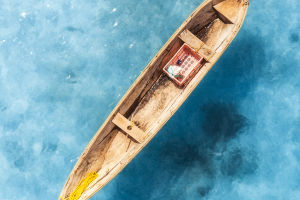As sailing events continue to flourish, sailing has increasingly captivated the interest and affection of many.
People are enamored with the sensation of battling the waves on the open sea. The ability to freely navigate a sailboat on the ocean, seamlessly blending with the wind and waves, is a dream for many.
Furthermore, as people's living standards rise, their pursuits have shifted from material possessions to spiritual fulfillment. Many now have the means to purchase their sailboat. But whether to buy a mono-hull ship or a catamaran?
History:
1. A catamaran is a vessel where a deck joins two hulls. Although catamaran design is relatively modern and commonly seen in competitive and recreational boat designs, its use dates back centuries in Polynesia.
Early humans utilized catamarans as a solution for navigating from rivers to the sea without capsizing. These early designs evolved into catamaran sailboats capable of withstanding rough seas.
Over time, it was discovered that catamarans, compared to monohull ships of the same tonnage, offered larger deck areas and cabin capacities, making them suitable for cargo ships. Since the 1960s, high-speed catamarans have gained popularity due to their spacious decks, interior room, and suitability for luxury embellishments.
2. Mono-hull ships have a long history from ancient maritime civilizations. Modern sailboats trace their roots to the Netherlands in the 17th century. Sailboat races between England and the Netherlands were held in 1662. The Royal Cork Yacht Club was established in Ireland in 1720. In 1851, the United Kingdom hosted the first America's Cup race. Today, sailboat races predominantly feature mono-hull ships.
Construction:
1. A catamaran consists of two separate underwater hulls connected by a reinforced framework, forming a single vessel. Each hull contains an engine and a propeller. The strong framework connecting the hulls is called a bridge deck, which typically houses multiple cabins.
Catamarans offer stability, safety, comfort, and maneuverability, making them popular for medium to small-sized passenger ferries. However, they have a complex structure, shorter rolling periods, and weaker midsection structures.
2. A mono-hull ship comprises a single hull, sails, masts, booms, keels, and rudders. Mono hull ships, being more significant and stable, have strong sail forces but are restricted to deep waters. They are lightweight, simple to construct, and easy to maneuver, allowing navigation in shallow waters. Mono hull ships typically require only 1-2 crew members to operate.
Advantages and Disadvantages:
Advantages of a catamaran:
- Catamarans offer numerous safety advantages, primarily stability during navigation.
- Catamarans possess genuine positive buoyancy due to their lightweight or foam construction and multiple watertight compartments. This means they remain afloat even if there's a collision or a hull breach. Unfortunately, mono-hull ships lack this feature, leaving you only a few minutes to react to damage or risk abandoning the boat.
Disadvantages of a catamaran:
- Catamarans incur higher mooring costs, typically 1.5 to 2 times more than mono hull ships. Moreover, their wider hulls make finding suitable repair facilities and transportation options challenging.
Advantages of a mono hull ship:
- Mono hull ships have been continuously refined, offering improved speed and agility, making them ideal for competitive sailing.
- They test sailors' ability to harness the power of the wind, making them a preferred choice for sailing enthusiasts seeking adventure on the high seas.
Disadvantages of a mono hull ship:
- Mono-hull ships have relatively limited space and experience significant rocking in rough weather, making them challenging for untrained individuals to handle. Therefore, a mono-hull ship might be the better choice if you're a sailing enthusiast who enjoys braving the elements.


